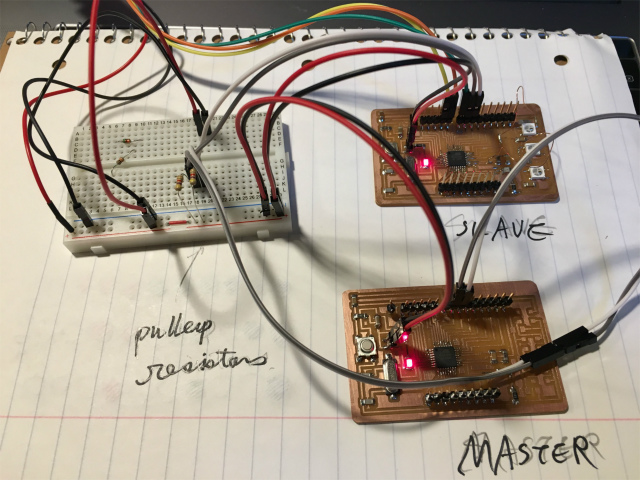Week 14. networking and communication
Assignment
- group project: send a message between two projects
- individual assignment: design and build a wired &/or wireless network connecting at least two processors
group assignment
see FabLab Kamakura's group assignment page.
introduction
As we learned last class, a lot of options for interface two components. In my final project, surFABoard will have GPS module, temperature sensors, and SD card logger at least as shown below.

When I want to add more sensors to a board, I think sensors with I2C interface would be a better choice than others, because the I2C protocol uses only two wires to communicate with other sensors(up to 128 devices).
As preparation for my final project, I chose I2C interface in this week assignment.

assignment
board preparation
I redraw a satshakit and added LEDs in week 12 which I used as a slave. I made another one, which I used as a master, to connect and communicate with them via I2C. I also wired pullup resistors both SCL and SDA line.

master writer/slave receiver
First, I tested a Master Writer/Slave Receiver sketch. Sketches for master and slave are followings.
master sketch
// Wire Master Writer
// by Nicholas Zambetti
// Demonstrates use of the Wire library
// Writes data to an I2C/TWI slave device
// Refer to the "Wire Slave Receiver" example for use with this
// Created 29 March 2006
// This example code is in the public domain.
#include <Wire.h>
void setup() {
Wire.begin(); // join i2c bus (address optional for master)
}
byte x = 0;
void loop() {
Wire.beginTransmission(8); // transmit to device #8
Wire.write("x is "); // sends five bytes
Wire.write(x); // sends one byte
Wire.endTransmission(); // stop transmitting
x++;
delay(500);
} slave sketch
// Wire Slave Receiver
// by Nicholas Zambetti
// Demonstrates use of the Wire library
// Receives data as an I2C/TWI slave device
// Refer to the "Wire Master Writer" example for use with this
// Created 29 March 2006
// This example code is in the public domain.
#include <Wire.h>
void setup() {
Wire.begin(8); // join i2c bus with address #8
Wire.onReceive(receiveEvent); // register event
Serial.begin(9600); // start serial for output
}
void loop() {
delay(100);
}
// function that executes whenever data is received from master
// this function is registered as an event, see setup()
void receiveEvent(int howMany) {
while (1 < Wire.available()) { // loop through all but the last
char c = Wire.read(); // receive byte as a character
Serial.print(c); // print the character
}
int x = Wire.read(); // receive byte as an integer
Serial.println(x); // print the integer
}
After uploading sketches to master and slave, I monitored slave's serial monitor. I found Data send by master was received by slave properly.
master reader/slave sender
Second, I also tested Master Reader/Slave Sender sketch. Sketches are followings.
master sketch
// Wire Master Reader
// by Nicholas Zambetti
// Demonstrates use of the Wire library
// Reads data from an I2C/TWI slave device
// Refer to the "Wire Slave Sender" example for use with this
// Created 29 March 2006
// This example code is in the public domain.
#include <Wire.h>
void setup() {
Wire.begin(); // join i2c bus (address optional for master)
Serial.begin(9600); // start serial for output
}
void loop() {
Wire.requestFrom(8, 6); // request 6 bytes from slave device #8
while (Wire.available()) { // slave may send less than requested
char c = Wire.read(); // receive a byte as character
Serial.print(c); // print the character
}
delay(500);
} slave sketch
// Wire Slave Sender
// by Nicholas Zambetti
// Demonstrates use of the Wire library
// Sends data as an I2C/TWI slave device
// Refer to the "Wire Master Reader" example for use with this
// Created 29 March 2006
// This example code is in the public domain.
#include <Wire.h>
void setup() {
Wire.begin(8); // join i2c bus with address #8
Wire.onRequest(requestEvent); // register event
}
void loop() {
delay(100);
}
// function that executes whenever data is requested by master
// this function is registered as an event, see setup()
void requestEvent() {
Wire.write("hello "); // respond with message of 6 bytes
// as expected by master
}
This time, I monitored a master device's serial monitor, and I found that master recieved a message from a slave.
I2C communication and LED blinking
I modified master writer/slave receiver sketch to blink various colors depending on the result of x modulo 10.

problem
LEDs didn't blink at all. I checked my Eagle design and found that I assigned both I2C SLC and LED's data line to same pin(PIN 19).

I cut the LED's data line and connected to PIN 14(A0).

Here is hero shot in this week.